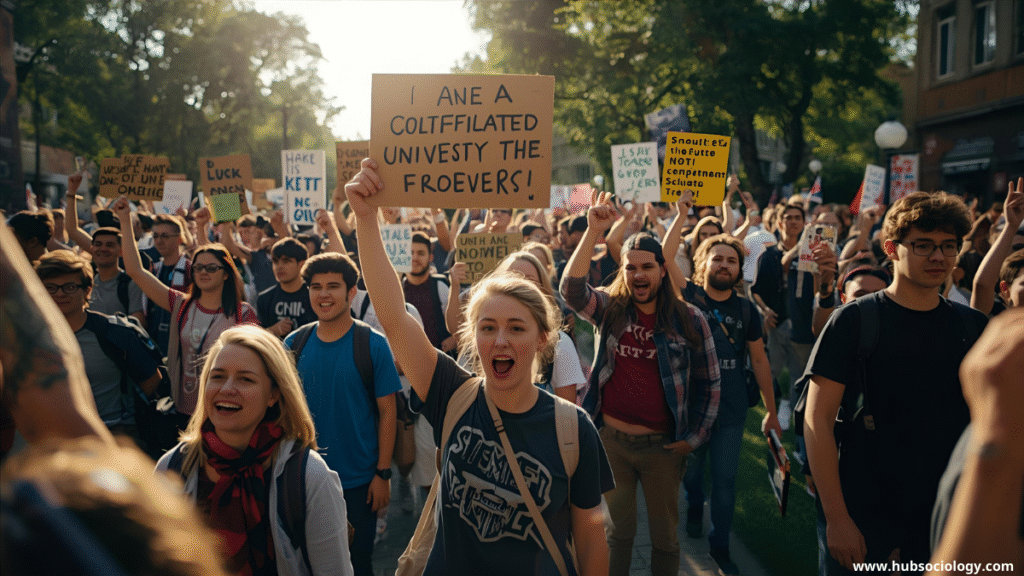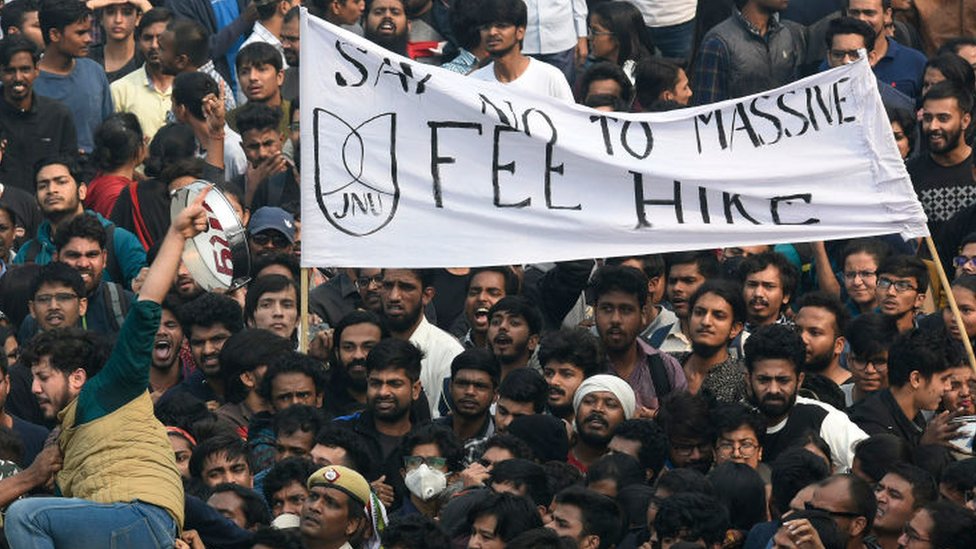Introduction
Student movements have historically played a transformative role in shaping societies, influencing politics, culture, and public policy. From the anti-colonial struggles of the 20th century to protests against authoritarian regimes, students have consistently emerged as powerful agents of change. In 2025, student movements across the world are once again rising to prominence, fueled by concerns over democracy, inequality, climate change, education reforms, gender justice, and digital surveillance. Unlike earlier decades, today’s movements are interconnected globally through digital platforms, making them not just localized protests but transnational campaigns.
This article examines student movements in 2025 through a sociological lens, exploring their causes, strategies, organizational structures, and the challenges they face. It also highlights how student activism reflects broader societal tensions and operates as a mirror of generational aspirations for justice, dignity, and equality.

Historical Context of Student Movements
Sociologically, student movements have always embodied the concept of “youth as a social category”—a transitional stage between dependence and full social responsibility. In the 1960s, student uprisings in France, Germany, and the United States reflected dissatisfaction with capitalism, militarism, and bureaucratic politics. In India, student activism contributed significantly to the independence struggle and later to movements like the JP Movement in the 1970s, which shaped democratic accountability.
This historical continuity underlines two key sociological insights:
- Students as moral vanguards: They articulate ethical concerns often neglected by mainstream politics.
- Students as catalysts of social change: They influence public discourse and inspire other marginalized groups to mobilize.
In 2025, student movements still carry these legacies, but with new dimensions shaped by globalization, digital technology, and shifting power structures.
Sociological Drivers of Student Movements in 2025
1. Educational Inequalities and Privatization
The rising cost of higher education, commercialization of universities, and unequal access to resources have made education a site of struggle. In both developed and developing countries, students are protesting fee hikes, debt burdens, and profit-driven educational models.
2. Climate Crisis and Environmental Justice
Climate anxiety is especially pronounced among younger generations. Students in 2025 are organizing climate strikes, demanding policies that prioritize renewable energy, biodiversity preservation, and climate justice for vulnerable communities.
3. Political Polarization and Authoritarianism
The erosion of democratic institutions in several countries has triggered student resistance. Movements in Eastern Europe, Asia, and parts of Africa highlight the demand for free speech, fair elections, and protection against state repression.
4. Gender, Sexuality, and Inclusion
Feminist student movements are challenging patriarchal norms on campuses, advocating for safer spaces, gender-neutral policies, and recognition of LGBTQ+ rights. This reflects a broader societal struggle for equality and human rights.
5. Digital Surveillance and Freedom
With the increasing use of AI-driven surveillance, censorship, and data exploitation, students are protesting to protect their digital freedoms. This issue connects to larger debates on privacy, democracy, and the ethics of technology.
6. Global Solidarity and Transnational Networks
Unlike past movements, 2025 student activism is characterized by networked solidarities. For instance, protests in one country often inspire others through viral campaigns, hashtags, and live-streaming of events.
Theoretical Frameworks in Understanding Student Movements
Sociology provides several conceptual tools to analyze student activism:
- Karl Mannheim’s “Problem of Generations” suggests that each generation experiences unique social conditions that shape their consciousness. The current generation of students is shaped by climate change, digital capitalism, and political polarization.
- Resource Mobilization Theory (RMT) explains how students use networks, technology, and cultural capital to organize and sustain movements.
- New Social Movement (NSM) Theory highlights how student movements today are less about class struggle and more about identity, culture, and values (e.g., feminism, ecology, LGBTQ+ rights).
- Conflict Theory views student protests as struggles against systemic inequalities perpetuated by state and market institutions.
Forms and Strategies of Student Movements in 2025
1. Digital Activism
Students use social media, encrypted messaging apps, and virtual forums to coordinate protests, spread awareness, and build solidarity. Digital spaces have become the new battleground for ideas.
2. Hybrid Protests
While online activism is crucial, physical demonstrations remain powerful. Students combine street marches with digital campaigns, ensuring both visibility and impact.
3. Cultural Resistance
Through art, music, street theatre, and memes, students create cultural symbols that resonate beyond academic spaces. This aligns with Antonio Gramsci’s notion of “cultural hegemony”, where counter-cultures challenge dominant ideologies.
4. Alliances with Civil Society
Students often collaborate with trade unions, NGOs, farmers’ groups, and women’s movements, amplifying their reach and legitimacy.
5. Decentralized Leadership
Unlike hierarchical models of the past, 2025 student movements emphasize horizontal leadership, collective decision-making, and inclusivity. This prevents co-optation and enhances resilience.
Global Case Studies of 2025 Student Movements
1. India: Protests Against Education Privatization
In several Indian states, students have mobilized against fee hikes and privatization of public universities. Movements emphasize the constitutional right to education and link their struggles to broader debates on inequality and unemployment.

2. United States: Climate and Debt Justice
American students are at the forefront of climate protests, demanding a Green New Deal for education. Simultaneously, campaigns against student loan debt highlight intergenerational injustice.
3. Europe: Anti-Austerity and Democracy Movements
Students in countries like Greece, Spain, and Poland are protesting austerity measures, authoritarian governments, and suppression of free speech. Universities have become spaces for democratic resistance.
4. Africa: Movements for Equal Access
In countries like South Africa, echoes of the #FeesMustFall movement continue, now linked with demands for decolonizing education and addressing racial inequality.
5. East Asia: Digital Rights and Democracy
Students in Hong Kong, Taiwan, and South Korea are actively engaging in movements for freedom of expression, digital rights, and protection against authoritarian surveillance.
Challenges Facing Student Movements in 2025
- State Repression: Governments increasingly use police violence, censorship, and surveillance to suppress dissent.
- Fragmentation: Diverse interests (climate, gender, democracy, fees) sometimes lead to lack of unified agendas.
- Co-optation: Political parties and corporations attempt to appropriate student causes for their own gain.
- Digital Fatigue: Overreliance on online platforms can lead to surveillance risks and burnout.
- Global Inequalities: Students in poorer countries face additional barriers, including lack of internet access, economic precarity, and political risks.
Sociological Implications of Student Movements
- Democratization of Public Sphere: Student movements expand democratic participation by voicing issues often ignored by elites.
- Generational Tensions: Conflicts between older conservative elites and younger progressive students reveal cultural shifts in values and ideologies.
- Transformation of Education: Movements question the role of universities—are they centers of critical thought or factories for labor markets?
- Global Consciousness: Student activism fosters a sense of global citizenship, emphasizing interconnected struggles like climate justice and digital freedom.
- Identity Politics and Solidarity: Student movements challenge traditional hierarchies of gender, race, caste, and sexuality, creating inclusive spaces for marginalized voices.
The Future of Student Movements
Looking forward, student movements in 2025 signal the rise of a new politics of hope and resistance. They will likely evolve in three major ways:
- Integration with Technology: Blockchain-based voting, decentralized digital platforms, and AI-driven advocacy may become part of activism.
- Stronger Transnational Solidarity: Future movements will be increasingly global, connecting students from different regions against shared issues like climate change and authoritarianism.
- Intersectional Approaches: Activism will integrate class, gender, ecology, and digital rights into holistic frameworks of justice.
Conclusion
Student movements in 2025 represent the voices of change in a world marked by crisis and transformation. They embody the spirit of resistance, creativity, and hope, reflecting a generation unwilling to accept injustice, inequality, or authoritarianism. From fee protests in India to climate strikes in the West, from digital rights campaigns in Asia to anti-austerity movements in Europe, students are reshaping the contours of public life.

Sociologically, these movements highlight the capacity of youth to act as agents of social transformation, challenging existing power structures and envisioning alternative futures. Despite challenges, the resilience, creativity, and solidarity of students ensure that their voices will continue to resonate as catalysts of change in the 21st century.
Do you like this this Article ? You Can follow as on :-
Facebook – https://www.facebook.com/hubsociology
Whatsapp Channel – https://whatsapp.com/channel/0029Vb6D8vGKWEKpJpu5QP0O
Gmail – hubsociology@gmail.com
